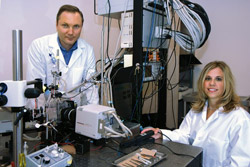Breaking down the barriers describes the efforts of the Office of Technology Management (OTM), the group dedicated to realizing the commercial potential of research. OTM evaluates discoveries, then licenses and patents technology developed by Washington University faculty. Michael T. Marrah, JD, and Bradley J. Castanho, PhD, were appointed co-directors of the office in January 2007, after serving as interim directors for nearly a year. Marrah, a skilled patent lawyer, and Castanho, a scientist with extensive experience in commercial development of biotechnology, answer questions about the challenges scientists face when translating discoveries into beneficial — and marketable — products.

What are OTM’s main priorities?
Marrah: We are building a stronger office so that we can handle more and better deals. So far, we’ve devoted considerable effort to getting the office organized, focused and developed so we have a strong infrastructure that can support a higher volume of better-quality deals all around. For example, we have implemented a docketing system that allows us to track and manage the university’s entire patent portfolio. A patent starts out as an application — and it can take anywhere from three to 10 years to get a patent approved. We have to keep track of each application every step of the way and, in the past, this had been done manually — literally on paper — which is incredibly time consuming. With an automated, centralized computer tool, we can more efficiently manage patent applications, and we’ll be able to meet deadlines faster.
Castanho: We want OTM to work more efficiently, with a turnaround time for licensing deals, contracts and research agreements that is substantially faster than what we have today. To accomplish this, we are bringing in people with more diverse skills. We already have senior-level people who are quite experienced, but we need other staff to support them. Before the end of 2007, we’ll add two additional people to handle licenses and contracts and one more to handle patents. We’ll be able to add this additional staff without increasing the overall budget because of efficiencies elsewhere. Eventually, over the next five years, other staff will be added.
How does OTM benefit the university and its faculty?
Castanho: The revenue that comes into the office from licenses, patents and research agreements is shared among the inventors (faculty), the university and OTM. Currently, 40 percent of revenue goes to the dean of the school represented by the faculty member. The dean then distributes these funds to the faculty member’s department or directly to his or her lab. That’s up to the discretion of each dean. Separately, the faculty member receives 35 percent of the total revenue, and he or she can decide to take it as income or invest it back into the research laboratory. The rest of the revenue — 25 percent — goes to OTM. So, 75 percent of the monies generated by licenses, patents or research agreements goes back to the inventors or to departments within the university, which supports our mission to teach and do research. As federal research funding becomes more competitive, one of the benefits of working with OTM is that licensing and/or patent revenue is a great conduit for faculty members to support their research projects. Some fund a substantial portion of their labs with this money, and this gives them autonomy from having to write so many grant proposals.
Marrah: OTM also provides nonfinancial research support. We negotiate and develop material transfer, licensing and master research agreements, which provide a way for researchers to do industry-sponsored research. This means faculty do not need to spend their time negotiating individual contracts and research agreements. A really vibrant OTM also can play a significant role in recruiting young, entrepreneurial faculty. These scientists want to know how much support they can expect from OTM for non-NIH funded research and the likelihood that OTM will be able to commercialize their technologies.

What advice do you have for faculty who think they might have something with commercial or patent potential?
Castanho: The key issue is to notify us as early as possible. If you publish before a patent application is filed, you lose a significant proportion of your patenting rights outside the United States. We also like to be ahead of the game and have enough lead time to evaluate intellectual property and to understand the potential commercial implications.
Marrah: We ideally need 30 to 90 days to do a market analysis, patentability analysis and title work for technologies with commercial application. The reality is that far too often we are notified and there’s not time to properly evaluate the technology. If faculty members contact us when they are ready to submit a manuscript for publication, that gives us plenty of time. If researchers think they have something of commercial value or that is patentable or a really novel idea, we want to hear from them.
What research strengths will OTM be building on in the years ahead?
Marrah: Washington University is widely recognized for its broad research base, which gives us many technologies to develop and, in recent years, has provided the basis for establishing specialized centers of expertise, such as the Hope Center for Neurological Disorders and the Consortium for Translational Research in Advanced Imaging and Nano- technology (C-TRAIN). These multidisciplinary centers focus on translational research — taking discoveries from the bench to the bedside. Certainly, there will be a high level of intellectual property to come out of those types of collaborations.
Castanho: Many new grants now require that intellectual property that develops from research be managed and licensed to interested companies. The government wants more value created from its investment and results that benefit society. In response, we need to be more sophisticated in looking for ways to translate basic science into technologies with commercial potential.